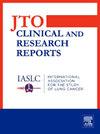CANOPY-N: A Phase 2 Study of Canakinumab or Pembrolizumab, Alone or in Combination, as Neoadjuvant Therapy in Patients With Resectable, Stage IB–IIIA NSCLC
IF 3.5
Q2 ONCOLOGY
引用次数: 0
Abstract
Introduction
Canakinumab is a human monoclonal anti–interleukin-1β antibody with the potential to enhance the activity of programmed death-ligand 1 inhibitors by inhibiting protumor inflammation.
Methods
CANOPY-N was a randomized, phase 2 study to evaluate safety and efficacy of neoadjuvant canakinumab (200 mg subcutaneous once every three weeks) and pembrolizumab (200 mg intravenous once every three weeks), either in combination or alone, in patients with early-stage (stage Ib–IIIa) NSCLC. The primary end point was major pathologic response (MPR) rates (≤10% of residual tumor cells) by central pathology review in the arms containing canakinumab. Secondary end points included overall response rates, safety, pharmacokinetics, surgical feasibility rates, and MPR rate in the pembrolizumab arm. The impact of treatment on surgical outcomes was assessed as an exploratory outcome.
Results
In total, 88 patients were enrolled: 35 to the canakinumab arm, 35 to the canakinumab + pembrolizumab arm, and 18 to the pembrolizumab arm. One patient (2.9%) in the canakinumab arm (95% confidence interval [CI]: 0.07–14.92), six patients (17.1%) in the canakinumab + pembrolizumab arm (95% CI: 6.56–33.65), and three patients (16.7%) in the pembrolizumab arm (95% CI: 3.58–41.42) achieved MPR. No unexpected safety signals were observed. Of the 84 patients (95.5%) who underwent operation, the prespecified 6-week window was achieved for 72 patients (85.7%).
Conclusions
Neoadjuvant treatment with canakinumab alone or combined with pembrolizumab did not improve MPR rates compared with pembrolizumab alone. No unexpected safety signals were observed and canakinumab did not adversely affect surgical outcomes. Intraoperative perihilar or perilobular fibrosis after neoadjuvant immunotherapy was rare.
CANOPY-N: Canakinumab或Pembrolizumab单独或联合作为可切除的IB-IIIA期NSCLC患者的新辅助治疗的2期研究
canakinumab是一种人单克隆抗白细胞介素-1β抗体,具有通过抑制肿瘤炎症来增强程序性死亡配体1抑制剂活性的潜力。方法scanopy - n是一项随机2期研究,旨在评估新辅助canakinumab (200 mg皮下注射,每3周一次)和pembrolizumab (200 mg静脉注射,每3周一次)联合或单独用于早期(Ib-IIIa期)NSCLC患者的安全性和有效性。主要终点是主要病理反应(MPR)率(≤残留肿瘤细胞的10%),在含有canakinumab的组中进行中心病理检查。次要终点包括派姆单抗组的总缓解率、安全性、药代动力学、手术可行性和MPR率。治疗对手术结果的影响作为探索性结果进行评估。结果共入组88例患者:canakinumab组35例,canakinumab + pembrolizumab组35例,pembrolizumab组18例。canakinumab组1例患者(2.9%)(95%可信区间[CI]: 0.07-14.92), canakinumab + pembrolizumab组6例患者(17.1%)(95% CI: 6.56-33.65), pembrolizumab组3例患者(16.7%)(95% CI: 3.58-41.42)达到MPR。没有观察到意外的安全信号。在84例(95.5%)接受手术的患者中,72例(85.7%)达到了预定的6周窗口期。结论与单独使用派姆单抗相比,单独使用canakinumab或联合使用派姆单抗并不能提高MPR率。没有观察到意外的安全信号,canakinumab对手术结果没有不利影响。新辅助免疫治疗后术中肝门周围或小叶周围纤维化是罕见的。
本文章由计算机程序翻译,如有差异,请以英文原文为准。
求助全文
约1分钟内获得全文
求助全文
来源期刊

JTO Clinical and Research Reports
Medicine-Oncology
CiteScore
4.20
自引率
0.00%
发文量
145
审稿时长
19 weeks
 求助内容:
求助内容: 应助结果提醒方式:
应助结果提醒方式:


